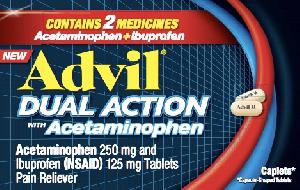Advil Dual Action Interactions
There are 525 drugs known to interact with Advil Dual Action (acetaminophen / ibuprofen), along with 14 disease interactions, and 3 alcohol/food interactions. Of the total drug interactions, 102 are major, 382 are moderate, and 41 are minor.
- View all 525 medications that may interact with Advil Dual Action
- View Advil Dual Action alcohol/food interactions (3)
- View Advil Dual Action disease interactions (14)
Most frequently checked interactions
View interaction reports for Advil Dual Action (acetaminophen / ibuprofen) and the medicines listed below.
- albuterol
- amlodipine
- aspirin
- atorvastatin
- Benadryl (diphenhydramine)
- cyclobenzaprine
- famotidine
- gabapentin
- ibuprofen
- levothyroxine
- lisinopril
- losartan
- magnesium oxide
- melatonin
- meloxicam
- Metoprolol Succinate ER (metoprolol)
- montelukast
- omeprazole
- ondansetron
- pantoprazole
- prednisone
- sertraline
- tramadol
- turmeric
- Tylenol (acetaminophen)
- Tylenol Extra Strength (acetaminophen)
- Vitamin B12 (cyanocobalamin)
- Vitamin C (ascorbic acid)
- Vitamin D3 (cholecalciferol)
- Zyrtec (cetirizine)
Advil Dual Action alcohol/food interactions
There are 3 alcohol/food interactions with Advil Dual Action (acetaminophen / ibuprofen).
Advil Dual Action disease interactions
There are 14 disease interactions with Advil Dual Action (acetaminophen / ibuprofen) which include:
- alcoholism
- liver disease
- asthma
- fluid retention
- GI toxicity
- rash
- renal toxicities
- thrombosis
- PKU
- PKU
- anemia
- hepatotoxicity
- hyperkalemia
- platelet aggregation inhibition
More about Advil Dual Action (acetaminophen / ibuprofen)
- Compare alternatives
- Drug images
- Side effects
- FDA approval history
- Drug class: analgesic combinations
Related treatment guides
Drug Interaction Classification
| Highly clinically significant. Avoid combinations; the risk of the interaction outweighs the benefit. | |
| Moderately clinically significant. Usually avoid combinations; use it only under special circumstances. | |
| Minimally clinically significant. Minimize risk; assess risk and consider an alternative drug, take steps to circumvent the interaction risk and/or institute a monitoring plan. | |
| No interaction information available. |
See also:
Further information
Always consult your healthcare provider to ensure the information displayed on this page applies to your personal circumstances.


